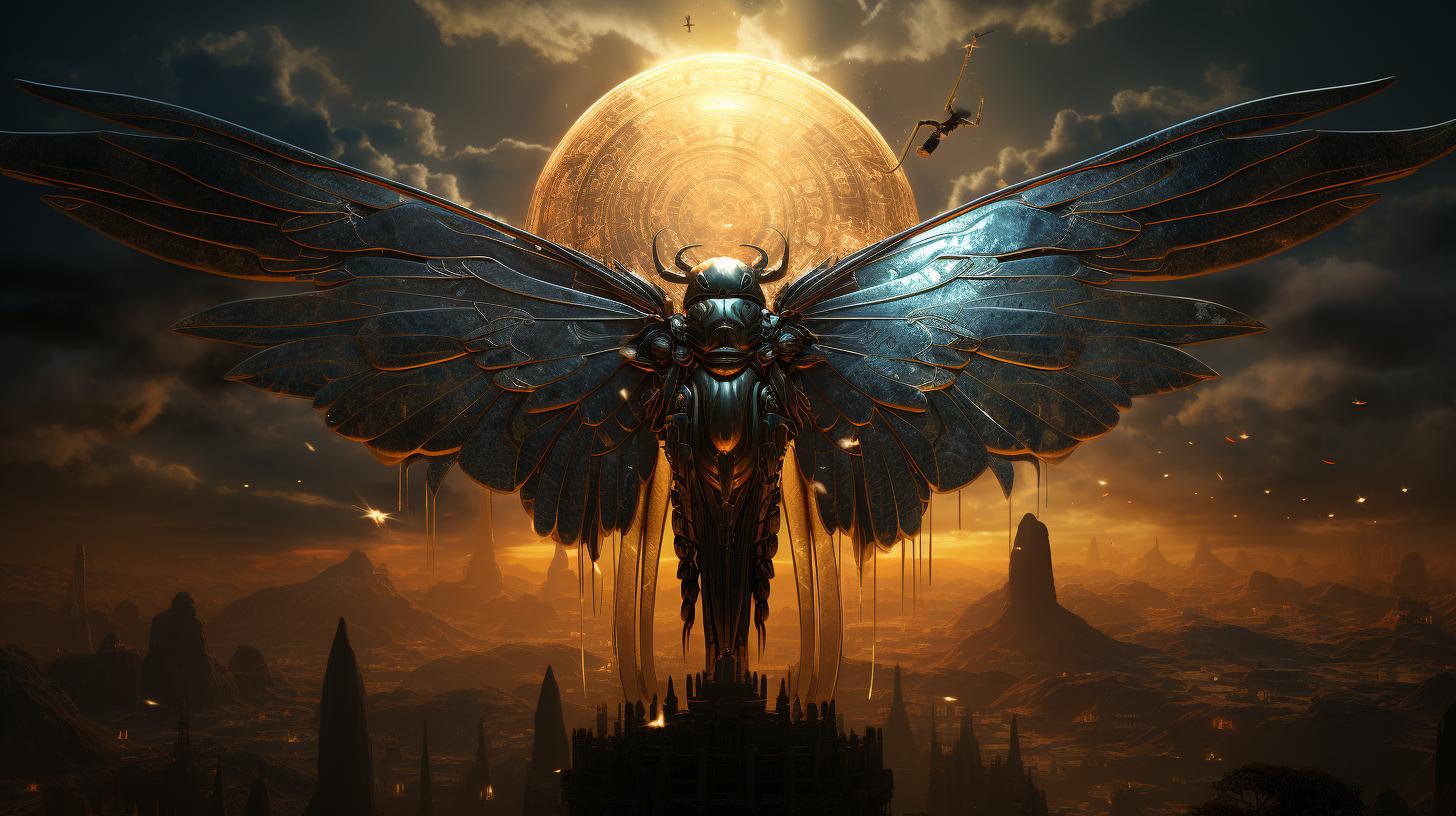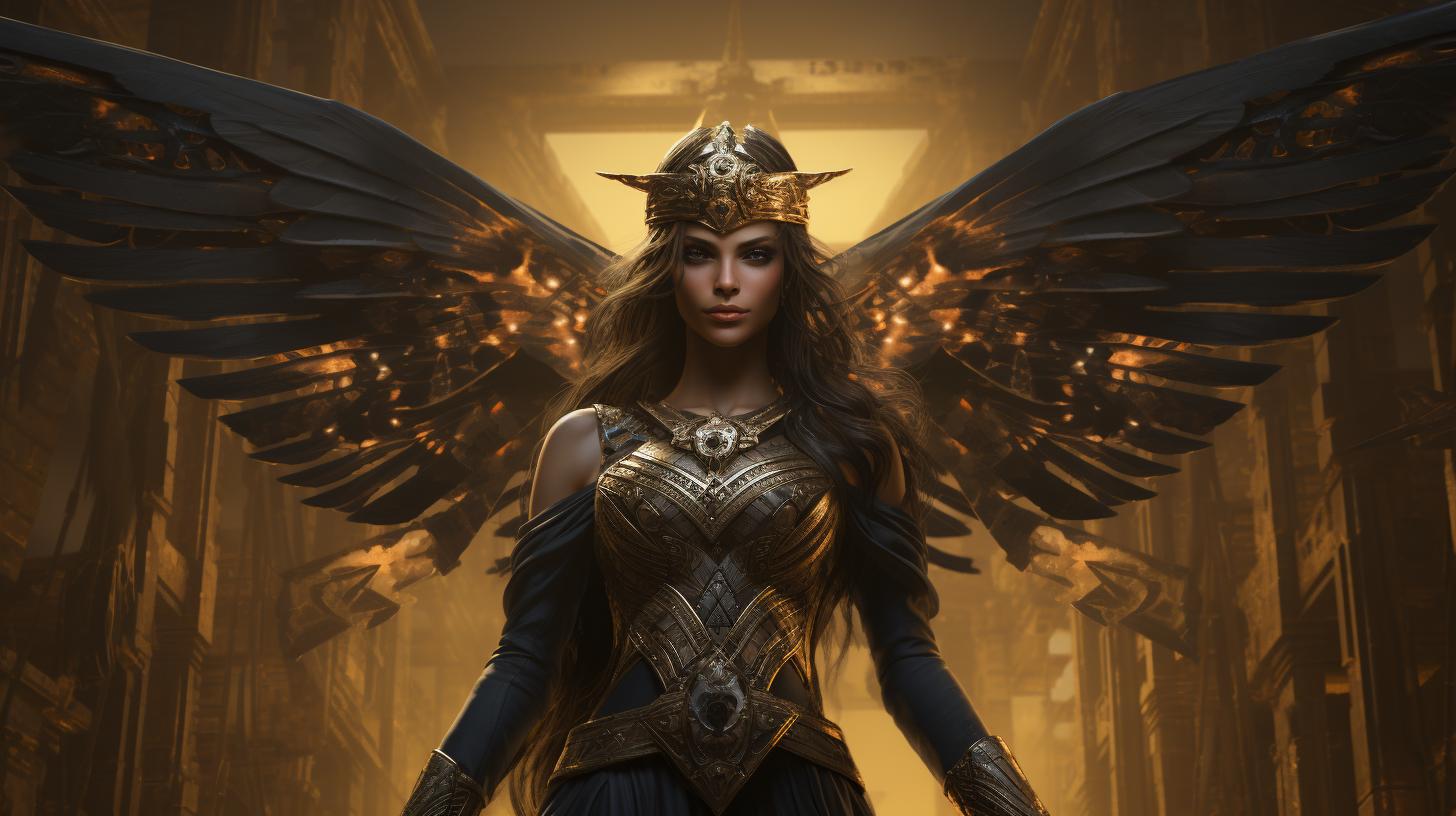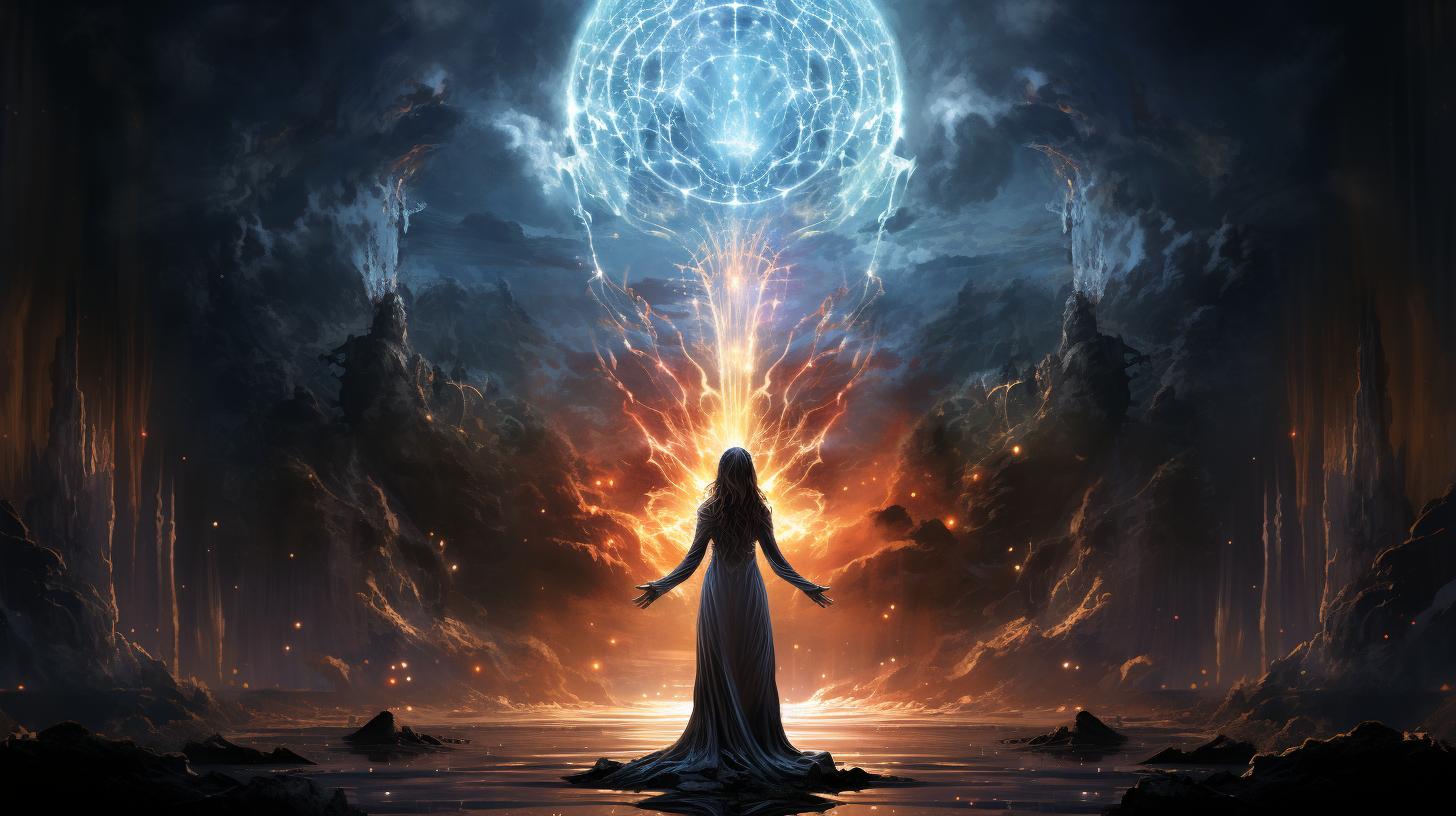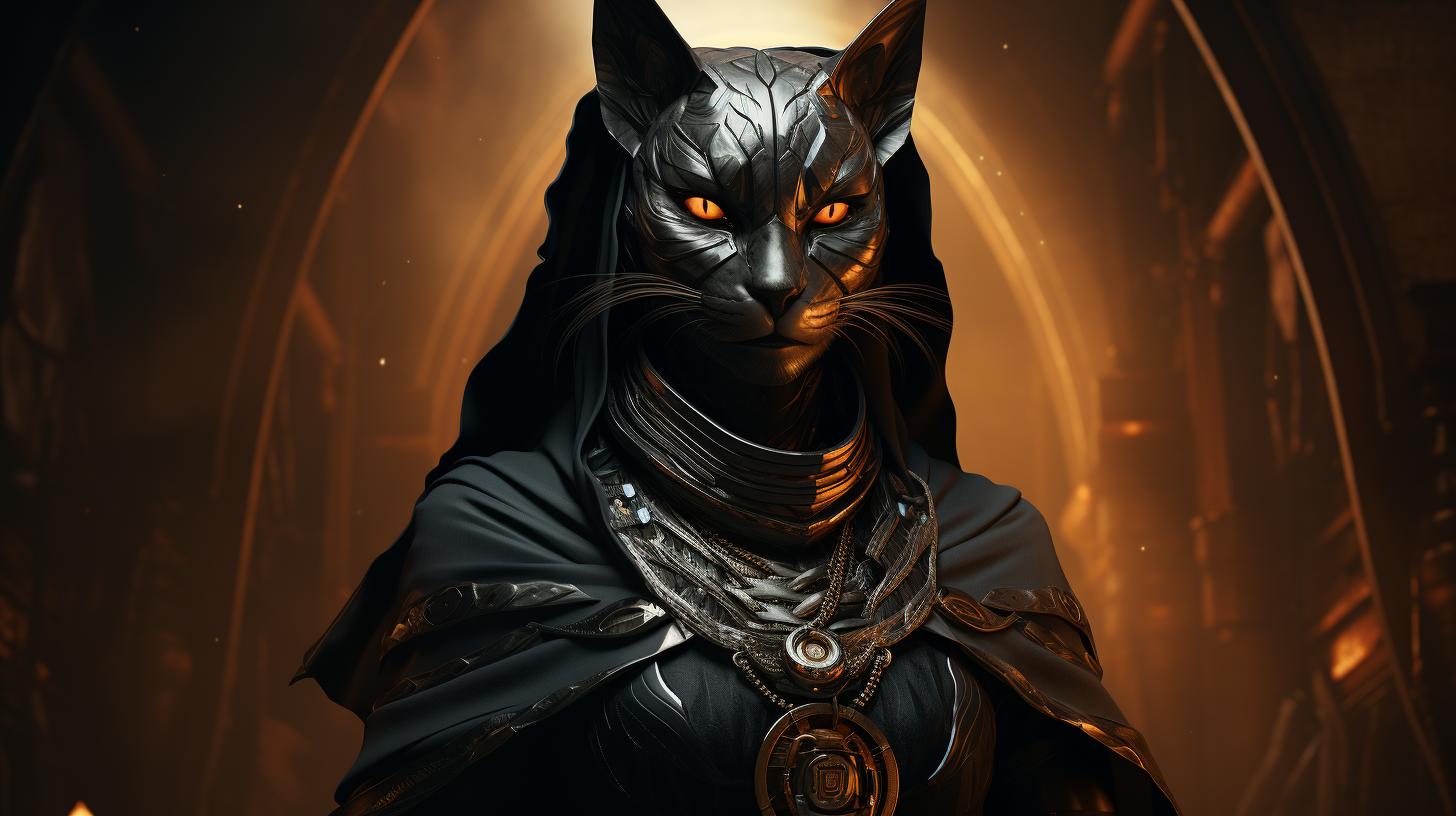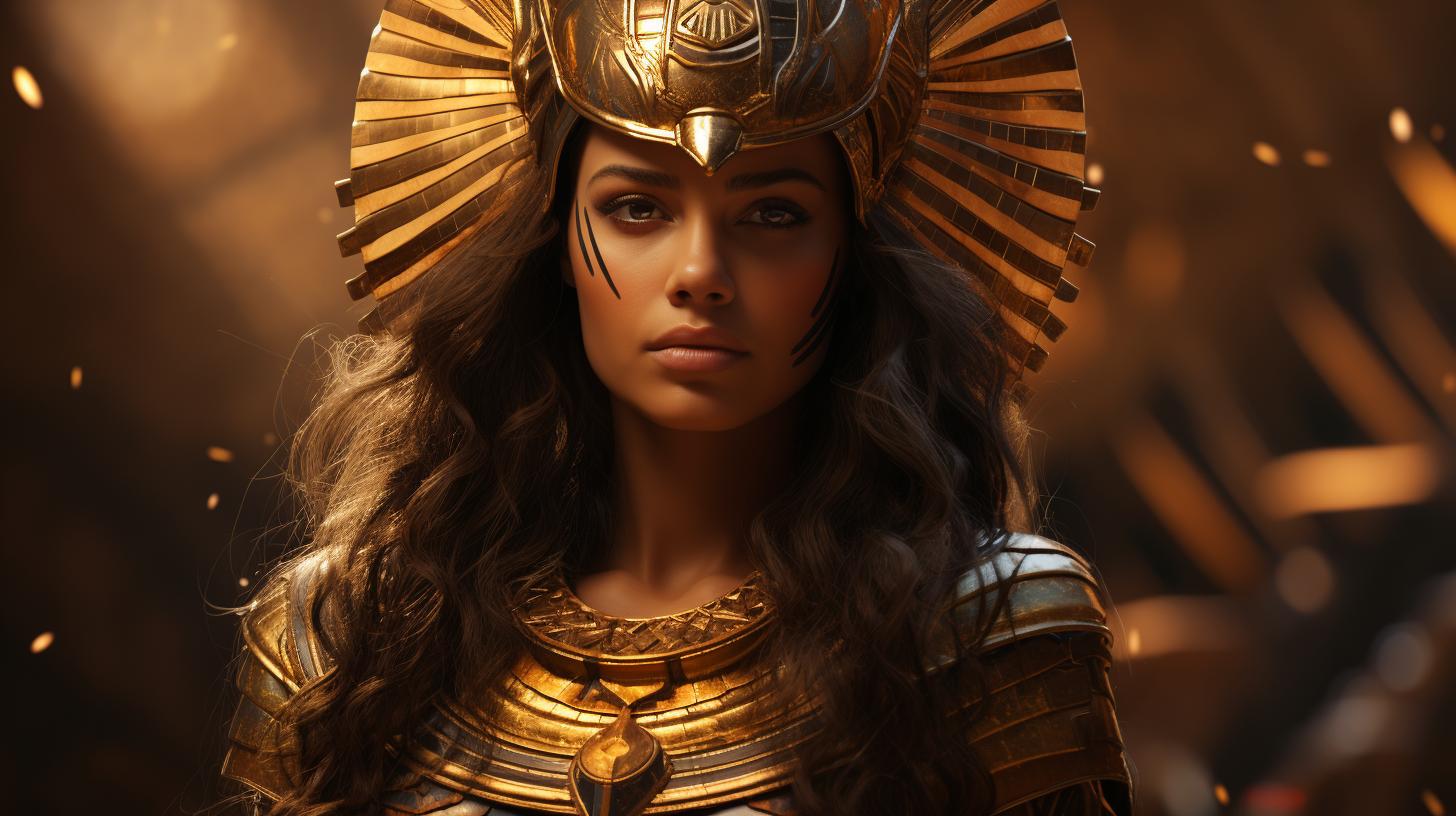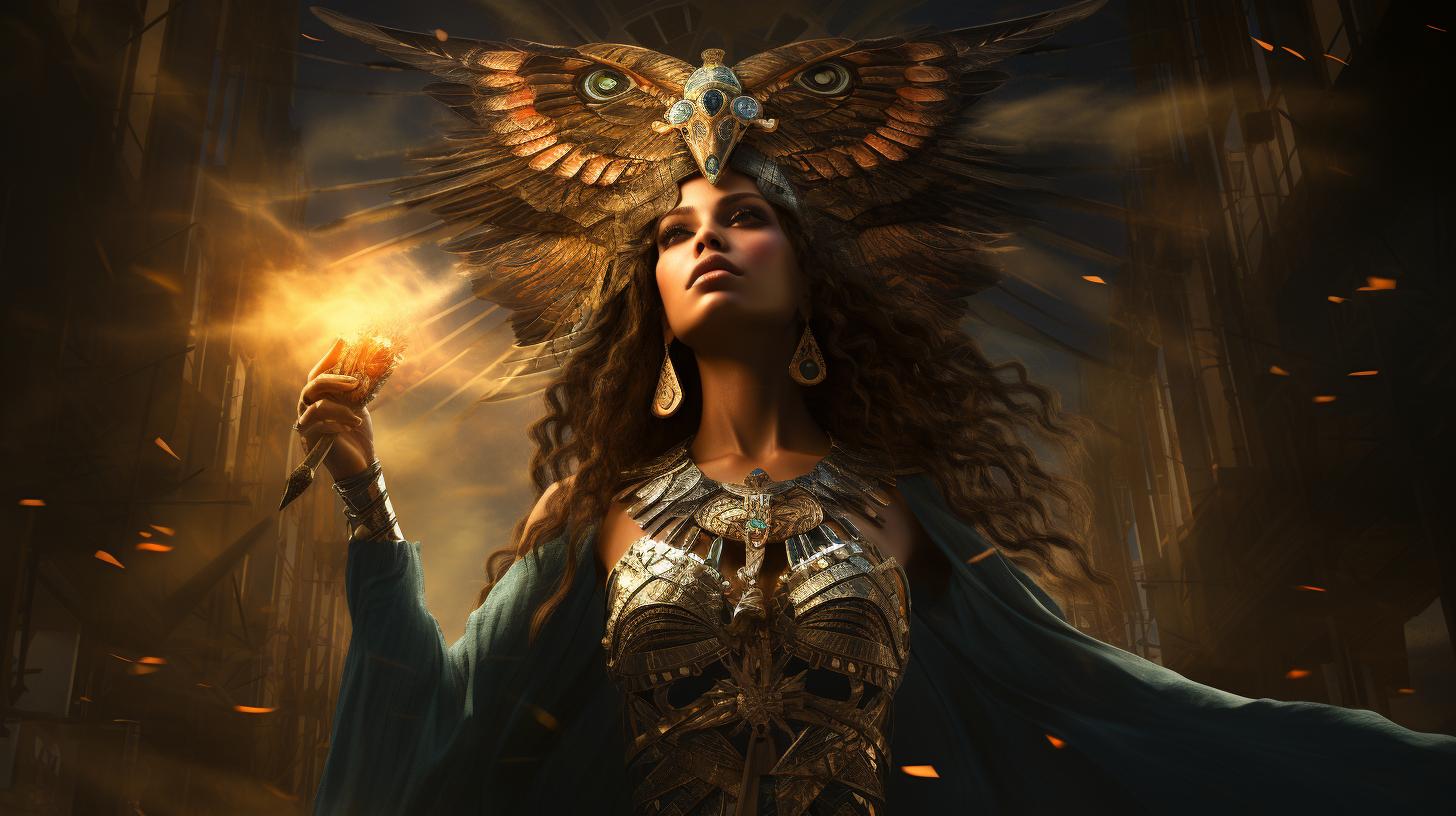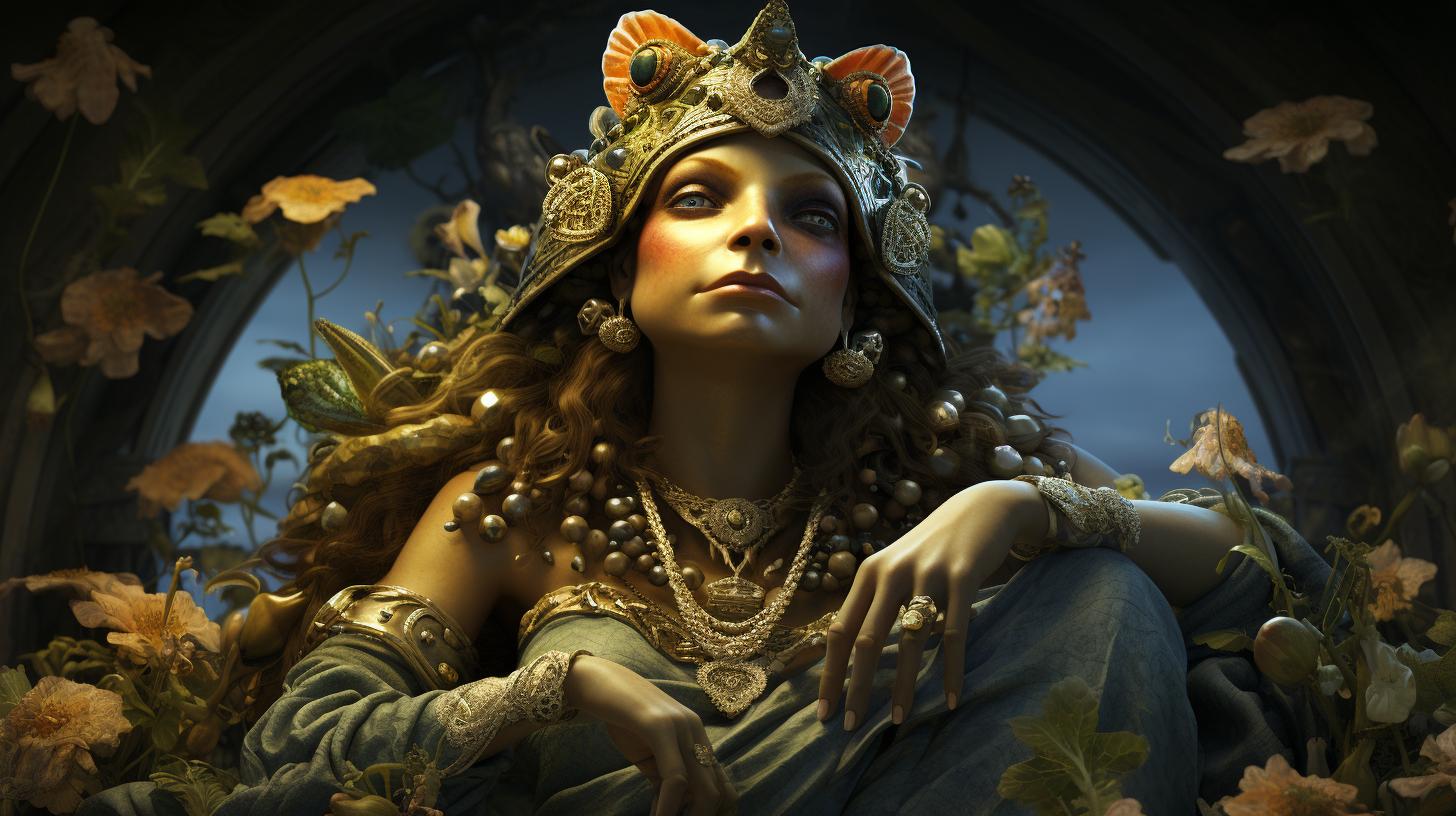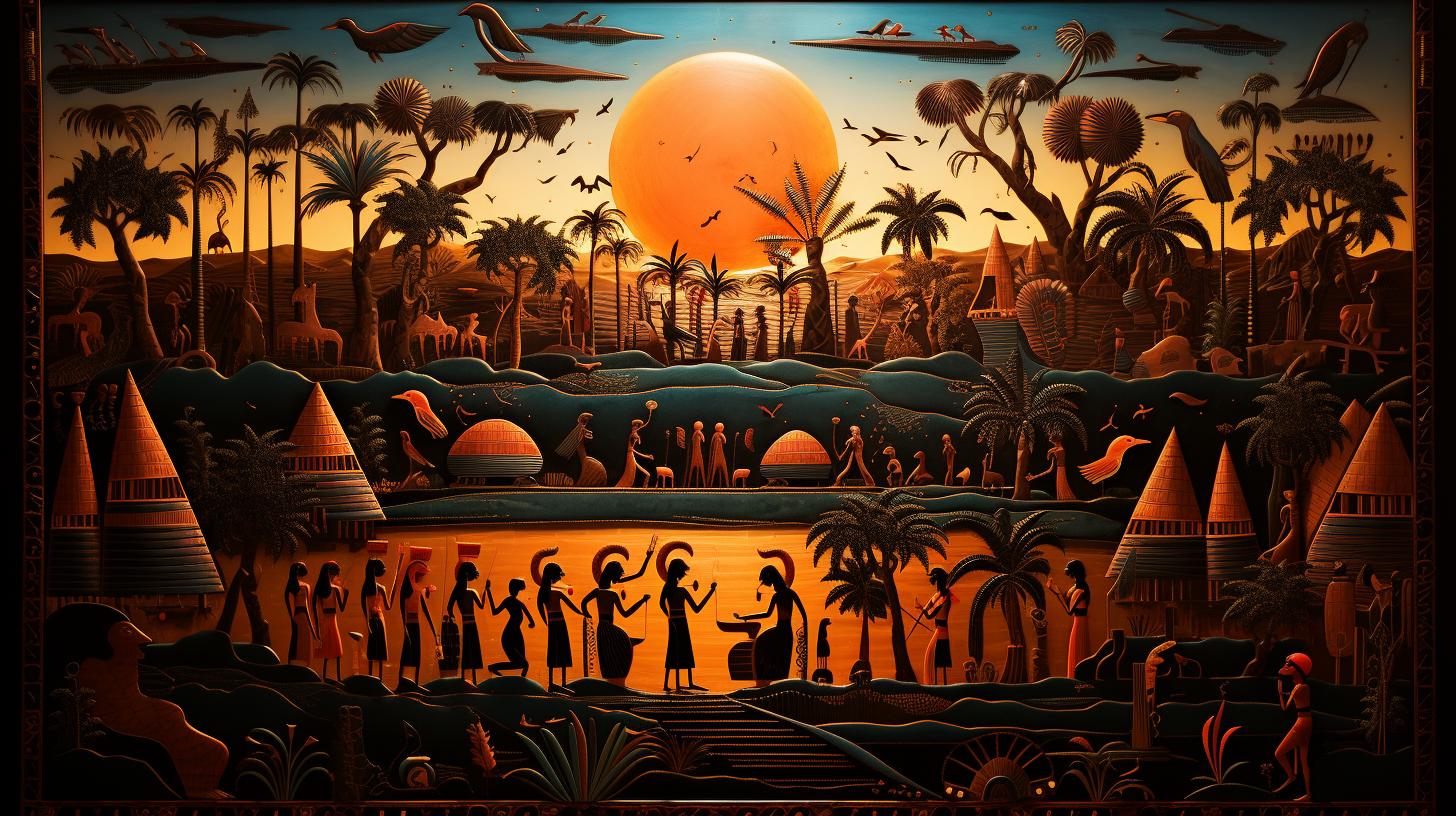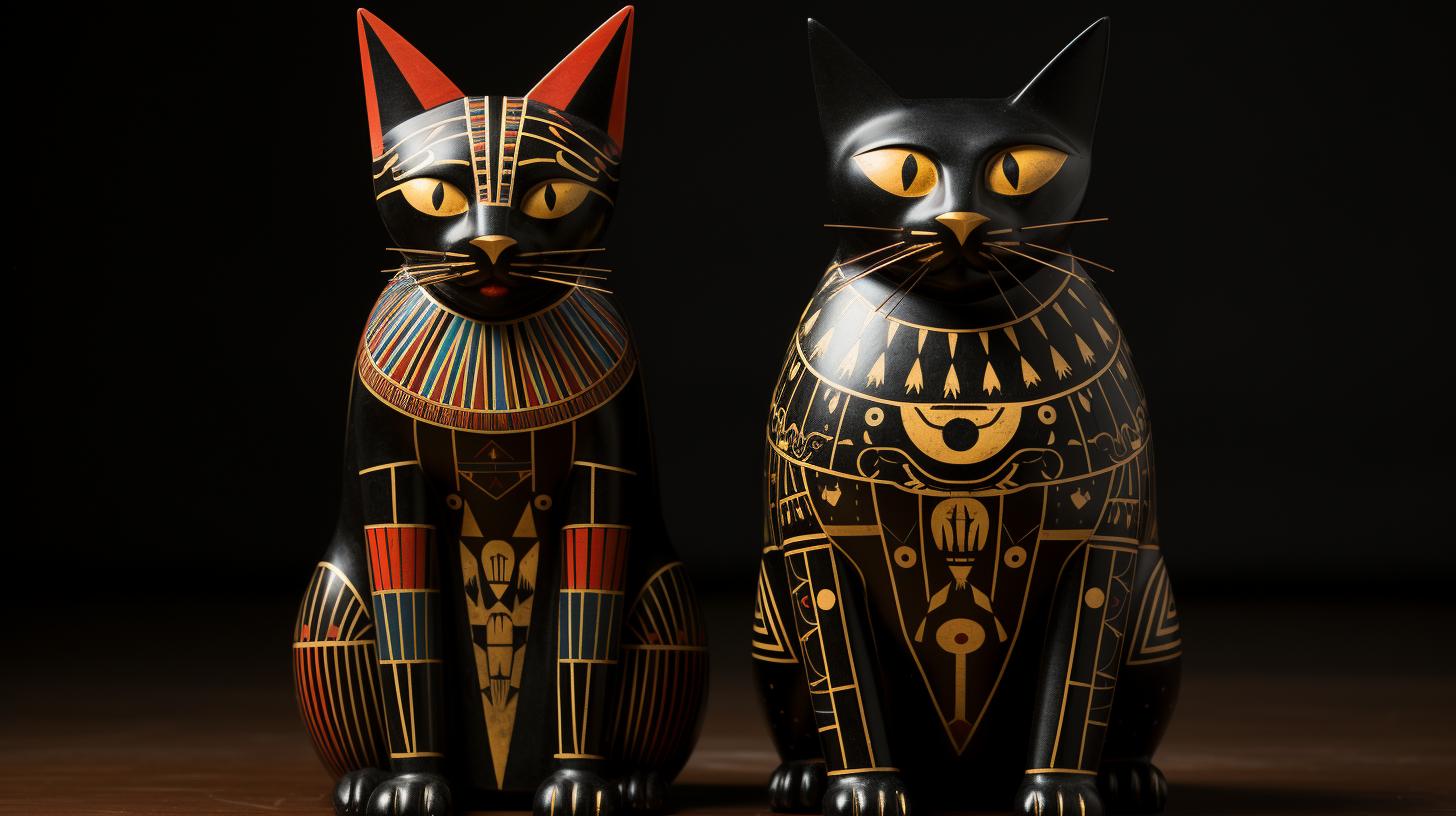Ancient Egyptian God Khepri Beetle: Symbol of Sun and Rebirth
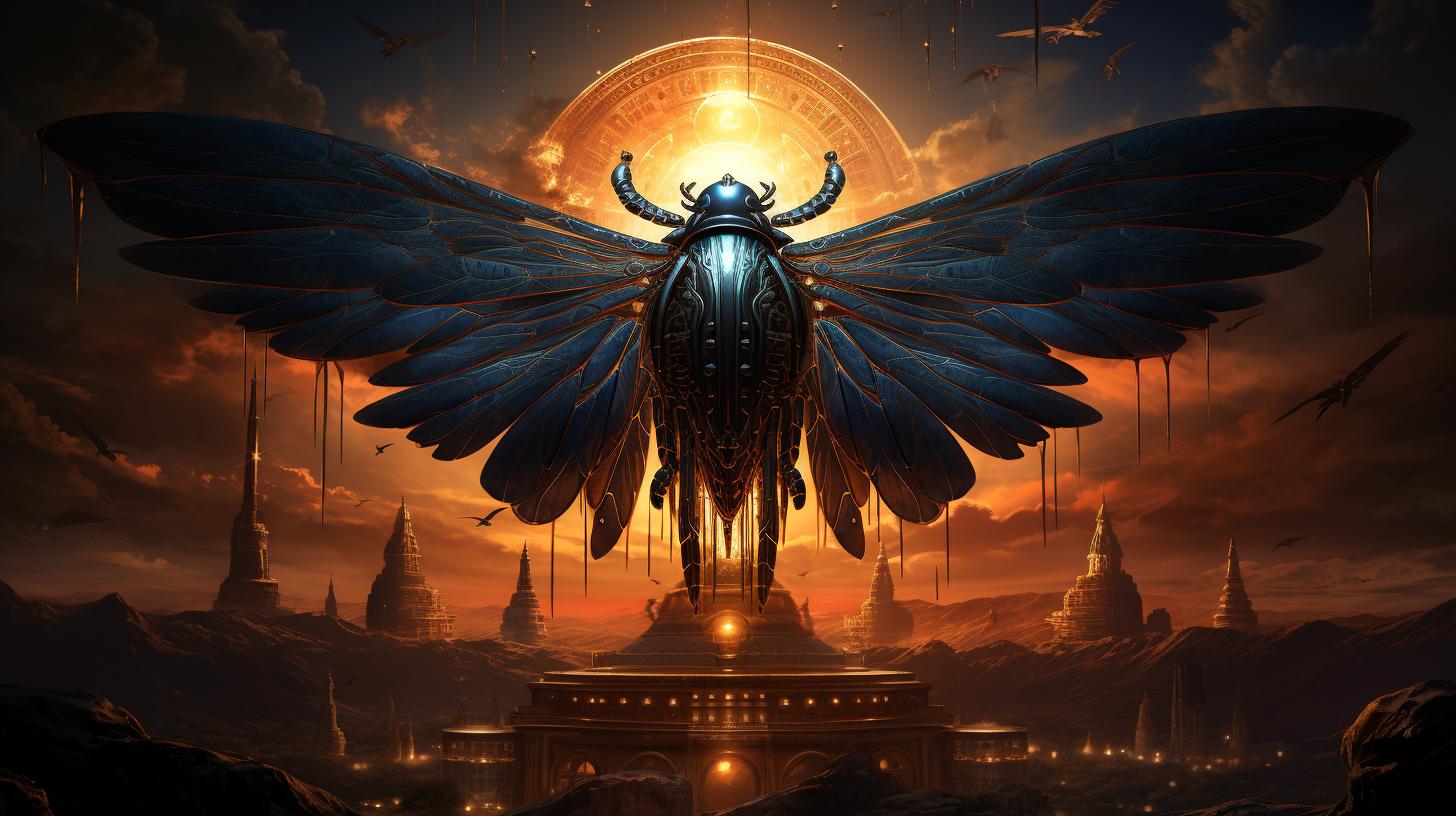
The ancient Egyptian god Khepri, associated with the beetle, held great significance in their religion. Khepri symbolized the rising sun and the power of transformation. Often depicted as a human with a beetle head, Khepri was believed to push the sun across the sky each day.
The use of scarab amulets, representing Khepri’s protection and rebirth, was widespread in ancient Egyptian culture. Khepri’s influence spanned various periods, reflecting the evolution of Egyptian religious beliefs. This article explores Khepri’s mythology, symbolism, role in creation myths, and impact on ancient Egyptian culture.
The Significance of Khepri in Ancient Egyptian Religion
In ancient Egyptian religion, the figure of Khepri held immense significance, representing the cycle of life, death, and rebirth. This deity, associated with the scarab beetle, was an essential component of their cosmology.
Khepri represented the emergence of the sun and its transformative power. Through mythology and symbolism, as well as depictions in art and iconography, Khepri’s role in Egyptian religion becomes evident.
The Mythology and Symbolism Behind Khepri
The mythology surrounding Khepri reveals the belief in his ability to push the sun across the sky, symbolizing the rising and setting of the sun. As a solar deity, Khepri embodied the concept of renewal, regeneration, and transformation.
The ancient Egyptians observed the scarab beetle rolling dung into a ball, connecting this action to the sun’s movement through the heavens. This symbolism emphasized Khepri’s association with creation and the rejuvenation of life.
Depiction of Khepri in Art and Iconography
Artistic representations of Khepri varied, with the deity often depicted as a human with a scarab beetle head or simply as a scarab beetle. These artistic depictions highlighted Khepri’s role in guiding the sun’s journey and promoting the cycle of life.
In some portrayals, Khepri is seen pushing the sun ahead of him, while in others, he is depicted riding a celestial barque. Often, Khepri wore the atef crown associated with Osiris, the god of resurrection and the afterlife.
Khepri’s Connection to the Sun and Creation
Khepri’s association with the sun is deeply rooted in ancient Egyptian beliefs. He was believed to push the sun ahead of him every day, ensuring its journey through the sky.
This constant motion mirrored the cyclical nature of creation and renewal. The scarab beetle’s life cycle, starting from laying eggs in dung to the emergence of adult beetles, symbolized Khepri’s connection to rebirth and transformation.
The Egyptians revered Khepri as a vital force in the continuous cycle of life, death, and resurrection.
Role of Khepri in Egyptian Cosmology and Creation Myths
Within ancient Egyptian cosmology and creation myths, Khepri played a significant role in shaping their religious beliefs and understanding of the universe. This section explores Khepri’s various aspects in relation to solar deities, other Egyptian gods, and the cycle of life, death, and rebirth.
Khepri as a Solar Deity and the Sun’s Journey
Khepri was revered as a solar deity, intimately associated with the sun’s journey across the sky. Unlike other gods who carried the sun on their backs or traveled in a celestial boat, Khepri pushed the sun ahead of him, symbolizing constant motion and renewal.
Every day, Khepri guided the sun’s ascent in the morning and descended with it into the underworld at night.
Khepri’s Relationship with Other Egyptian Gods
Khepri’s role extended beyond being a solar deity. He shared connections with prominent gods like Thoth, the ibis-headed god of science and knowledge, and Osiris, the god of resurrection and the underworld.
In some myths, Khepri was attributed as the creator of the universe, having either created it alone or in conjunction with Ra. Furthermore, Khepri was believed to have fathered gods Shu and Tefnut through a sexual union with his own shadow.
Khepri’s Role in the Cycle of Life, Death, and Rebirth
Khepri’s association with the scarab beetle underscored his role in the cycle of life, death, and rebirth. Just as the scarab larvae develop within dung and emerge into adulthood, Khepri was considered to undergo a similar metamorphosis in the underworld.
His emergence from darkness represented the transition from death to vibrant, active life. This belief in resurrection and renewal resonated deeply in Egyptian culture and connected Khepri to their funerary practices, where scarab-shaped amulets were buried alongside mummified bodies to ensure safe passage through the afterlife.
In conclusion, Khepri held a crucial role in Egyptian cosmology and creation myths. As a solar deity, he propelled the sun’s journey across the sky, signifying constant motion and renewal. His connections with other gods expanded his significance beyond solar worship.
Additionally, his association with the scarab beetle symbolized the transformative cycle of life, death, and rebirth, influencing Egyptian beliefs and funerary practices.
Amulets and Talismans: Khepri’s Influence in Ancient Egyptian Culture
Amulets and talismans played a significant role in ancient Egyptian culture, particularly in relation to the god Khepri.
These artifacts, often shaped as scarab beetles, held immense symbolism and were believed to attract the power and protection of Khepri, the god associated with the sun and transformation.
The Use of Scarab Amulets and their Symbolism
Scarab amulets were widely used in ancient Egypt, serving as powerful symbols of Khepri’s influence.
These amulets were often made of various materials, such as stone or faience, and were intricately carved with detailed designs. The scarab beetle itself represented the journey of the sun, mirroring Khepri’s role in driving the sun across the sky each day.
The scarab beetle’s ability to lay its eggs in dung and emerge as thriving adults also contributed to its symbolism of rebirth and transformation. The Egyptians believed that by wearing scarab amulets, they could secure their own renewal and ensure safe passage through the afterlife.
Protective Powers and Beliefs Associated with Scarabs
Apart from their symbolic significance, scarab amulets were regarded for their protective properties. It was believed that wearing these amulets could ward off evil spirits, provide good luck, and bring prosperity.
The scarab’s association with Khepri, the god of the sun, further enhanced its protective powers.
Many scarab amulets were inscribed with magical spells or prayers to amplify their effectiveness. These inscriptions invoked Khepri’s blessings and safeguarded the wearer from harm, both in life and in the afterlife.
The amulets served as a constant reminder of Khepri’s transformative power and the cyclical nature of existence.
Burial Practices and Khepri’s Role in the Afterlife
Khepri’s influence extended to burial practices in ancient Egypt. It was customary to place scarab amulets in the burial chambers of the deceased. These amulets were believed to assist the soul in its journey through the afterlife, guiding it towards resurrection and rebirth.
A sense of continuity was established through the association of Khepri with the scarab beetle and its life cycle. Just as the scarab buries its eggs in dung, the deceased would be laid to rest, symbolically paving the way for their own transformation and eventual resurrection.
By aligning themselves with Khepri’s power, the ancient Egyptians sought eternal life and renewal.
- Khepri’s symbolism in scarab amulets
- Protective powers and beliefs linked to scarabs
- Scarab amulets in burial practices and the afterlife
As Khepri’s influence permeated ancient Egyptian culture, scarab amulets became powerful symbols of protection, renewal, and a connection to the divine.
The utilization of these talismans reflected a deep belief in the transformative power of Khepri and the cyclical nature of life and death.
Khepri and the Evolution of Egyptian Religious Beliefs
Khepri’s influence in Egyptian religious beliefs underwent significant development and transformation throughout different periods in Egyptian history.
This section examines the development of Khepri’s cult and worship, his influence in various periods such as the Old Kingdom, Middle Kingdom, and New Kingdom, as well as his lasting legacy in Egyptian religion and iconography.
Development of Khepri’s Cult and Worship
The cult and worship of Khepri evolved over time, aligning with the changing religious practices and beliefs in ancient Egypt. Initially, Khepri was associated with the scarab beetle and held a prominent place in the religious rituals performed by the Egyptians.
The ancient Egyptians revered Khepri as the god of the rising sun and its transformative power.
As time went on, Khepri’s cult gained more followers and became intertwined with the worship of other prominent deities.
Temples were not exclusively dedicated to Khepri, but his presence was felt in various religious sanctuaries throughout Egypt. The rituals and offerings made in his honor aimed to ensure the continuation of life, rebirth, and prosperity.
Influence of Khepri in Different Periods: Old Kingdom, Middle Kingdom, and New Kingdom
Khepri’s influence in Egyptian religious beliefs varied across different periods of Egyptian history. During the Old Kingdom, Khepri played a crucial role in the solar theology, being associated with the sun god Ra.
The Egyptians believed that Khepri pushed the sun across the sky, symbolizing the eternal cycle of sunrise and rebirth.
In the Middle Kingdom, the cult of Khepri expanded further, and his association with the creation and renewal gained prominence.
He was often depicted as a human with the head of a scarab beetle, representing the transformative power of the sun. Khepri’s presence was particularly significant in mortuary texts and rituals, emphasizing his role in the afterlife.
The New Kingdom witnessed a resurgence of interest in Khepri, and his connection with Ra became even more pronounced. He became a prominent figure in royal iconography, with many pharaohs incorporating Khepri’s name into their own.
Khepri’s symbolism extended to concepts of divine kingship and the cyclical nature of life and death.
Khepri’s Legacy and Continuity in Egyptian Religion and Iconography
Khepri’s influence endured beyond specific historical periods, leaving a lasting legacy in Egyptian religion and iconography. His symbolism as a symbol of transformation, rebirth, and the power of the sun remained significant throughout Egyptian history.
The scarab beetle, associated with Khepri, remained a popular amulet and symbol of protection. Scarabs were often inscribed with prayers or spells to ensure the wearer’s safe passage through the afterlife.
Khepri’s legacy was deeply intertwined with funerary practices and beliefs, emphasizing the cyclical nature of life and the journey through the underworld.
In Egyptian art and iconography, Khepri continued to be depicted as a human with the head of a scarab beetle, representing the transformative power of the sun and the enduring cycle of life.
His imagery found its way into various aspects of Egyptian culture, including architecture, jewelry, and royal regalia.
.

